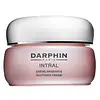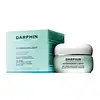What's inside
What's inside
 Key Ingredients
Key Ingredients

 Benefits
Benefits

 Concerns
Concerns

 Ingredients Side-by-side
Ingredients Side-by-side

Water
Skin ConditioningHydrogenated Polydecene
EmollientButyrospermum Parkii Butter
Skin ConditioningPropylene Glycol
HumectantGlyceryl Stearate
EmollientPEG-100 Stearate
Dimethicone
EmollientCetyl Alcohol
EmollientOctyldodecyl Stearoyl Stearate
EmollientPropanediol
SolventTridecyl Stearate
EmollientButylene Glycol
HumectantTridecyl Trimellitate
EmollientChamomilla Recutita Flower Extract
MaskingPaeonia Suffruticosa Root Extract
Skin ProtectingAlteromonas Ferment Extract
Skin ConditioningCrataegus Monogyna Flower Extract
Skin ConditioningPanthenol
Skin ConditioningVanilla Planifolia Fruit Extract
Skin ConditioningRosa Damascena Flower Water
MaskingDipentaerythrityl Hexacaprylate/Hexacaprate
EmulsifyingBisabolol
MaskingStearic Acid
CleansingTocopheryl Acetate
AntioxidantSorbitol
HumectantSodium Hyaluronate
HumectantPalmitic Acid
EmollientSodium PCA
HumectantSodium Polyacrylate
AbsorbentCaprylyl Glycol
EmollientAcrylates/C10-30 Alkyl Acrylate Crosspolymer
Emulsion Stabilising1,2-Hexanediol
Skin ConditioningXanthan Gum
EmulsifyingSodium Hydroxide
BufferingCitronellol
PerfumingGeraniol
PerfumingTetrasodium EDTA
Water, Hydrogenated Polydecene, Butyrospermum Parkii Butter, Propylene Glycol, Glyceryl Stearate, PEG-100 Stearate, Dimethicone, Cetyl Alcohol, Octyldodecyl Stearoyl Stearate, Propanediol, Tridecyl Stearate, Butylene Glycol, Tridecyl Trimellitate, Chamomilla Recutita Flower Extract, Paeonia Suffruticosa Root Extract, Alteromonas Ferment Extract, Crataegus Monogyna Flower Extract, Panthenol, Vanilla Planifolia Fruit Extract, Rosa Damascena Flower Water, Dipentaerythrityl Hexacaprylate/Hexacaprate, Bisabolol, Stearic Acid, Tocopheryl Acetate, Sorbitol, Sodium Hyaluronate, Palmitic Acid, Sodium PCA, Sodium Polyacrylate, Caprylyl Glycol, Acrylates/C10-30 Alkyl Acrylate Crosspolymer, 1,2-Hexanediol, Xanthan Gum, Sodium Hydroxide, Citronellol, Geraniol, Tetrasodium EDTA
Water
Skin ConditioningGlycerin
HumectantDimethicone
EmollientPolysorbate 60
EmulsifyingCetyl Palmitate
EmollientPropanediol
SolventHydrogenated Polydecene
EmollientSorbitan Stearate
EmulsifyingSqualane
EmollientImperata Cylindrica Root Extract
Skin ConditioningTridecyl Stearate
EmollientCucumis Sativus Fruit Extract
EmollientActinidia Chinensis Fruit Extract
EmollientSalicornia Herbacea Extract
Skin ConditioningLavandula Stoechas Extract
MaskingTridecyl Trimellitate
EmollientButylene Glycol
HumectantTocopheryl Acetate
AntioxidantDipentaerythrityl Hexacaprylate/Hexacaprate
EmulsifyingPanthenol
Skin ConditioningAcrylates/C10-30 Alkyl Acrylate Crosspolymer
Emulsion StabilisingCaprylic/Capric Triglyceride
MaskingEthylhexylglycerin
Skin ConditioningDimethiconol
EmollientHydrogenated Vegetable Oil
EmollientHydroxyethyl Acrylate/Sodium Acryloyldimethyl Taurate Copolymer
Emulsion StabilisingIsohexadecane
EmollientSodium Hyaluronate
HumectantCaprylyl Glycol
EmollientSodium Hydroxide
BufferingCarbomer
Emulsion StabilisingTetrasodium EDTA
Sodium Benzoate
MaskingChlorphenesin
AntimicrobialParfum
MaskingAlpha-Isomethyl Ionone
PerfumingLimonene
PerfumingButylphenyl Methylpropional
PerfumingHexyl Cinnamal
PerfumingLinalool
PerfumingHydroxyisohexyl 3-Cyclohexene Carboxaldehyde
MaskingHydroxycitronellal
PerfumingCitronellol
PerfumingBenzyl Benzoate
AntimicrobialCitral
PerfumingGeraniol
PerfumingCI 19140
Cosmetic ColorantCI 42090
Cosmetic ColorantWater, Glycerin, Dimethicone, Polysorbate 60, Cetyl Palmitate, Propanediol, Hydrogenated Polydecene, Sorbitan Stearate, Squalane, Imperata Cylindrica Root Extract, Tridecyl Stearate, Cucumis Sativus Fruit Extract, Actinidia Chinensis Fruit Extract, Salicornia Herbacea Extract, Lavandula Stoechas Extract, Tridecyl Trimellitate, Butylene Glycol, Tocopheryl Acetate, Dipentaerythrityl Hexacaprylate/Hexacaprate, Panthenol, Acrylates/C10-30 Alkyl Acrylate Crosspolymer, Caprylic/Capric Triglyceride, Ethylhexylglycerin, Dimethiconol, Hydrogenated Vegetable Oil, Hydroxyethyl Acrylate/Sodium Acryloyldimethyl Taurate Copolymer, Isohexadecane, Sodium Hyaluronate, Caprylyl Glycol, Sodium Hydroxide, Carbomer, Tetrasodium EDTA, Sodium Benzoate, Chlorphenesin, Parfum, Alpha-Isomethyl Ionone, Limonene, Butylphenyl Methylpropional, Hexyl Cinnamal, Linalool, Hydroxyisohexyl 3-Cyclohexene Carboxaldehyde, Hydroxycitronellal, Citronellol, Benzyl Benzoate, Citral, Geraniol, CI 19140, CI 42090
Ingredients Explained
These ingredients are found in both products.
Ingredients higher up in an ingredient list are typically present in a larger amount.
Acrylates/C10-30 Alkyl Acrylate Crosspolymer is a synthetic polymer. It is used to thicken and improve the texture of products. Due to its properties, it can prevent water and oil ingredients from separating.
Butylene Glycol (or BG) is used within cosmetic products for a few different reasons:
Overall, Butylene Glycol is a safe and well-rounded ingredient that works well with other ingredients.
Though this ingredient works well with most skin types, some people with sensitive skin may experience a reaction such as allergic rashes, closed comedones, or itchiness.
Learn more about Butylene GlycolCaprylyl Glycol is a humectant and emollient, meaning it attracts and preserves moisture.
It is a common ingredient in many products, especially those designed to hydrate skin. The primary benefits are retaining moisture, skin softening, and promoting a healthy skin barrier.
Though Caprylyl Glycol is an alcohol derived from fatty acids, it is not the kind that can dry out skin.
This ingredient is also used as a preservative to extend the life of products. It has slight antimicrobial properties.
Learn more about Caprylyl GlycolCitronellol is used to add fragrance/parfum to a product. It is often derived from plants such as roses. In fact, it can be found in many essential oils including geranium, lavender, neroli, and more. The scent of Citronellol is often described as "fresh, grassy, and citrus-like".
Since the Citronellol molecule is already unstable, Citronellol becomes irritating on the skin when exposed to air.
Citronellol is a modified terpene. Terpenes are unsaturated hydrocarbons found in plants. They make up the primary part of essential oils.
Citronellol is not able to be absorbed into deeper layers of the skin. It has low permeability,
Citronellol is also a natural insect repellent.
Learn more about CitronellolDimethicone is a type of synthetic silicone created from natural materials such as quartz.
What it does:
Dimethicone comes in different viscosities:
Depending on the viscosity, dimethicone has different properties.
Ingredients lists don't always show which type is used, so we recommend reaching out to the brand if you have questions about the viscosity.
This ingredient is unlikely to cause irritation because it does not get absorbed into skin. However, people with silicone allergies should be careful about using this ingredient.
Note: Dimethicone may contribute to pilling. This is because it is not oil or water soluble, so pilling may occur when layered with products. When mixed with heavy oils in a formula, the outcome is also quite greasy.
Learn more about DimethiconeWe don't have a description for Dipentaerythrityl Hexacaprylate/Hexacaprate yet.
Geraniol is used to add fragrance/parfum to a product. It is the main component of citronellol. It is a monoterpenoid and an alcohol.
Monoterpenes are naturally found in many parts of different plants.
Geraniol can be found in many essential oils including Rose Oil and Citronella Oil. The scent of Geraniol is often described as "rose-like". Many foods also contain Geraniol for fruit flavoring.
Geraniol can irritate the skin when exposed to air. However, irritation depends on the ability of geraniol to penetrate into the skin. In general, geraniol is not able to penetrate skin easily.
Geraniol is colorless and has low water-solubility. However, it is soluble in common organic solvents.
Like citronellol, it is a natural insect repellent.
2,6-Octadien-1-ol, 3,7-dimethyl-, (2E)-
Learn more about GeraniolHydrogenated Polydecene is an emollient. It creates a non-occlusive film on the skin that offers extra protection for your skin barrier.
The texture of Hydrogenated Polydecene ranges from light and silky to rich.
Hydrogenated Polydecene is the end compound of controlled hydrogenation of Polydecene.
Learn more about Hydrogenated PolydecenePanthenol is a common ingredient that helps hydrate and soothe the skin. It is found naturally in our skin and hair.
There are two forms of panthenol: D and L.
D-panthenol is also known as dexpanthenol. Most cosmetics use dexpanthenol or a mixture of D and L-panthenol.
Panthenol is famous due to its ability to go deeper into the skin's layers. Using this ingredient has numerous pros (and no cons):
Like hyaluronic acid, panthenol is a humectant. Humectants are able to bind and hold large amounts of water to keep skin hydrated.
This ingredient works well for wound healing. It works by increasing tissue in the wound and helps close open wounds.
Once oxidized, panthenol converts to pantothenic acid. Panthothenic acid is found in all living cells.
This ingredient is also referred to as pro-vitamin B5.
Learn more about PanthenolPropanediol is an all-star ingredient. It softens, hydrates, and smooths the skin.
It’s often used to:
Propanediol is not likely to cause sensitivity and considered safe to use. It is derived from corn or petroleum with a clear color and no scent.
Learn more about PropanediolSodium Hyaluronate is hyaluronic acid's salt form. It is commonly derived from the sodium salt of hyaluronic acid.
Like hyaluronic acid, it is great at holding water and acts as a humectant. This makes it a great skin hydrating ingredient.
Sodium Hyaluronate is naturally occurring in our bodies and is mostly found in eye fluid and joints.
These are some other common types of Hyaluronic Acid:
Learn more about Sodium HyaluronateSodium Hydroxide is also known as lye or caustic soda. It is used to adjust the pH of products; many ingredients require a specific pH to be effective.
In small amounts, sodium hydroxide is considered safe to use. However, large amounts may cause chemical burns due to its high alkaline.
Your skin has a natural pH and acid mantle. This acid mantle helps prevent harmful bacteria from breaking through. The acid mantle also helps keep your skin hydrated.
"Alkaline" refers to a high pH level. A low pH level would be considered acidic.
Learn more about Sodium HydroxideTetrasodium EDTA is the salt formed from neutralizing ethylenediamine tetraacetic acid with sodium hydroxide. It is a chelating agent and used to prevent metal ions from binding to other ingredients. This helps keep the product and ingredients stable.
Tetrasodium EDTA comes as a white solid and is soluble in water.
Tocopheryl Acetate is AKA Vitamin E. It is an antioxidant and protects your skin from free radicals. Free radicals damage the skin by breaking down collagen.
One study found using Tocopheryl Acetate with Vitamin C decreased the number of sunburned cells.
Tocopheryl Acetate is commonly found in both skincare and dietary supplements.
Learn more about Tocopheryl AcetateTridecyl Stearate isn't fungal acne safe.
Tridecyl Trimellitate is a synthetic ingredient with emollient and skin conditioning properties. It also acts as a texture enhancer and helps products spread easily without feeling greasy.
As an emollient, it forms a light layer on the skin that keeps moisture in and improves water resistance. This is why you'll often find this ingredient in eye creams and other rich treatments.
This ingredient is seen as the elegant alternative to mineral oil.
Learn more about Tridecyl TrimellitateWater. It's the most common cosmetic ingredient of all. You'll usually see it at the top of ingredient lists, meaning that it makes up the largest part of the product.
So why is it so popular? Water most often acts as a solvent - this means that it helps dissolve other ingredients into the formulation.
You'll also recognize water as that liquid we all need to stay alive. If you see this, drink a glass of water. Stay hydrated!
Learn more about Water